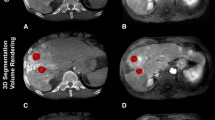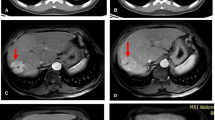Abstract
The purpose of this study was to compare the ability of multidetector computed tomography (MDCT) and magnetic resonance imaging (MRI) to evaluate treatment results after transarterial chemoembolization (TACE), with a special focus on the influence of Lipiodol on calculation of tumor necrosis according to EASL criteria. A total of 115 nodules in 20 patients (17 males, 3 females; 69.5 ± 9.35 years) with biopsy-proven hepatocellular carcinoma were treated with TACE. Embolization was performed using a doxorubicin-Lipiodol emulsion (group I) or DC Beads loaded with doxorubicin (group II). Follow-up included triphasic contrast-enhanced 64-row MDCT (collimation, 0.625 mm; slice, 3 mm; contrast bolus, 120 ml iomeprol; delay by bolus trigger) and contrast-enhanced MRI (T1 native, T2 native; five dynamic contrast-enhanced phases; 0.1 mmol/kg body weight gadolinium-DTPA; slice thickness, 4 mm). Residual tumor and the extent of tumor necrosis were evaluated according to EASL. Contrast enhancement within tumor lesions was suspected to represent vital tumor. In the Lipiodol-based TACE protocol, MDCT underestimated residual viable tumor compared to MRI, due to Lipiodol artifacts (23.2% vs 47.7% after first, 11.9% vs 31.2% after second, and 11.4% vs 23.7% after third TACE; p = 0.0014, p < 0.001, and p < 0.001, respectively). In contrast to MDCT, MRI was completely free of any artifacts caused by Lipiodol. In the DC Bead-based Lipiodol-free TACE protocol, MRI and CT showed similar residual tumor and rating of treatment results (46.4% vs 41.2%, 31.9 vs 26.8%, and 26.0% vs 25.6%; n.s.). In conclusion, MRI is superior to MDCT for detection of viable tumor residuals after Lipiodol-based TACE. Since viable tumor tissue is superimposed by Lipiodol artifacts in MDCT, MRI is mandatory for reliable decision-making during follow-up after Lipiodol-based TACE protocols.







Similar content being viewed by others
References
Parkin DM, Bray F, Ferlay J et al (2001) Estimating the world cancer burden: Globocan 2000. Int J Cancer 94:153–156
Liu Q, Song Y, Zhou Y et al (2006) A useful agent for chemoprevention of hepatocellular carcinoma? Cancer Biol Ther 5:1674–1676
Lodato F, Mazzella G, Festi D et al (2006) Hepatocellular carcinoma prevention: a worldwide emergence between the opulence of developed countries and the economic constraints of developing nations. World J Gastroenterol 12:7239–7249
Llovet JM, Bru C, Bruix J (1999) Prognosis of hepatocellular carcinoma: the BCLC staging classification. Semin Liver Dis 19:329–338
Bruix J, Llovet JM (2002) Prognostic prediction and treatment strategy in hepatocellular carcinoma. Hepatology 35:519–524
Llovet JM, Fuster J, Bruix J (2004) Barcelona-Clínic Liver Cancer Group. The Barcelona approach: diagnosis, staging, and treatment of hepatocellular carcinoma. Liver Transpl 10:115–120
Cillo U, Bassanello M, Vitale A et al (2004) The critical issue of hepatocellular carcinoma prognostic classification: Which is the best tool available? J Hepatol 40:124–131
Cillo U, Vitale A, Grigoletto F et al (2006) Prospective validation of the Barcelona Clinic Liver Cancer staging system. J Hepatol 44:723–731
De Giorgio M, Fagiuoli S (2007) Management of hepatocellular carcinoma. Dig Dis 25:279–281
Llovet JM, Bruix J (2003) Systematic review of randomized trials for unresectable hepatocellular carcinoma: chemoembolization improves survival. Hepatology 37:429–442
Satake M, Uchida H, Arai Y et al (2008) Transcatheter arterial chemoembolization (TACE) with lipiodol to treat hepatocellular carcinoma: survey results from the TACE study group of Japan. CardioVasc Interv Radiol 31:756–761
Hihara T, Araki T, Kachi et al (1992) Dense parenchymal accumulation of Lipiodol after transarterial chemoembolization. Radiat Med 10:79–81
Takayama T, Makuuchi M, Hirohashi S et al (1990) Malignant transformation of adenomatous hyperplasia to hepatocellular carcinoma. Lancet 336:1150–1153
Bruix J, Sherman M, Llovet JM et al (2001) EASL Panel of Experts on HCC. Clinical management of hepatocellular carcinoma. Conclusions of the Barcelona-2000 EASL conference. European Association for the Study of the Liver. J Hepatol 35:421–430
Therasse P, Arbuck SG, Eisenhauer EA et al (2000) New guidelines to evaluate the response to treatment in solid tumors. J Natl Cancer Inst 92:205–216
Padhani AR, Ollivier L (2001) The RECIST criteria: implications for diagnostic radiologists. Br J Radiol 74:983–986
Bruix J, Sherman M (2005) Management of hepatocellular carcinoma. Hepatology 42:1208–1236
Herber S, Biesterfeld S, Franz U et al (2008) Correlation of multislice CT and histomorphology in HCC following TACE: predictors of outcome. CardioVasc Interv Radiol 31:768–777
Castrucci M, Sironi S, De Cobelli F et al (1996) Plain and gadolinium-DTPA-enhanced MR imaging of hepatocellular carcinoma treated with transarterial chemoembolization. Abdom Imaging 21:488–494
Semelka RC, Worawattanakul S, Mauro MA et al (1998) Malignant hepatic tumors: changes on MRI after hepatic arterial chemoembolization-preliminary findings. J Magn Reson Imaging 8:48–56
Kubota K, Hisa N, Nishikawa T et al (2001) Evaluation of hepatocellular carcinoma after treatment with transcatheter arterial chemoembolization: comparison of Lipiodol-CT, power Doppler sonography, and dynamic MRI. Abdom Imaging 26:184–190
De Santis M, Alborino S, Tartoni PL et al (1997) Effects of lipiodol retention on MRI signal intensity from hepatocellular carcinoma and surrounding liver treated by chemoembolization. Eur Radiol 7:10–16
Marelli L, Stigliano R, Triantos C et al (2007) Transarterial therapy for hepatocellular carcinoma: Which technique is more effective? A systematic review of cohort and randomized studies. CardioVasc Interv Radiol 30:6–25
Lewis AL, Gonzalez MV, Lloyd AW et al (2006) DC Bead: in vitro characterization of a drug-delivery device for transarterial chemoembolization. J Vasc Interv Radiol 17:335–342
Johnson PJ, Kalayci C, Dobbs N et al (1991) Pharmacokinetics and toxicity of intraarterial adriamycin for hepatocellular carcinoma: effect of coadministration of lipiodol. J Hepatol 13:120–127
Sultana S, Awai K, Nakayama Y et al (2007) Hypervascular hepatocellular carcinomas: bolus tracking with a 40-detector CT scanner to time arterial phase imaging. Radiology 243:140–147
Alba E, Valls C, Dominguez J et al (2008) Transcatheter arterial chemoembolization in patients with hepatocellular carcinoma on the waiting list for orthotopic liver transplantation. AJR Am J Roentgenol 190:1341–1348
Author information
Authors and Affiliations
Corresponding author
Rights and permissions
About this article
Cite this article
Kloeckner, R., Otto, G., Biesterfeld, S. et al. MDCT Versus MRI Assessment of Tumor Response After Transarterial Chemoembolization for the Treatment of Hepatocellular Carcinoma. Cardiovasc Intervent Radiol 33, 532–540 (2010). https://doi.org/10.1007/s00270-009-9728-y
Received:
Accepted:
Published:
Issue Date:
DOI: https://doi.org/10.1007/s00270-009-9728-y




